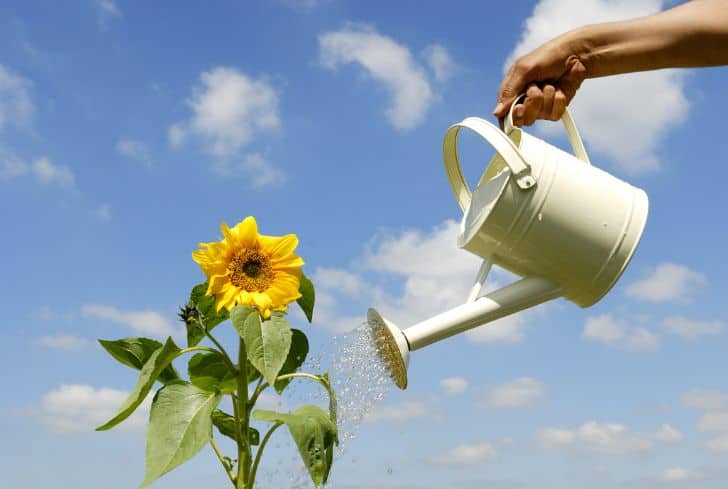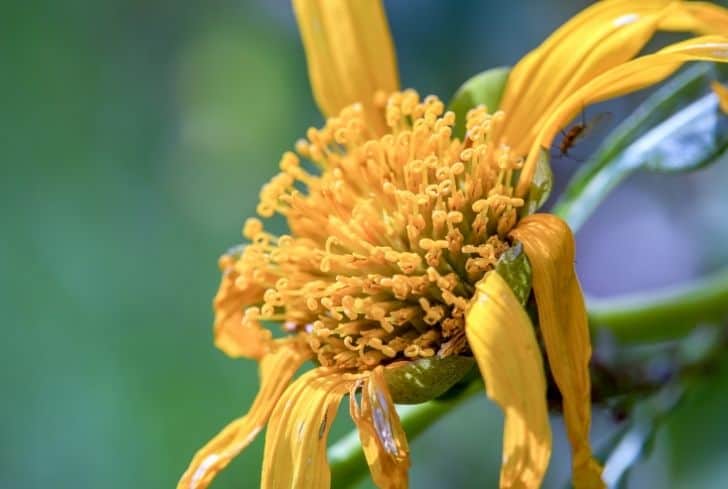Sunflowers are gorgeous and a must-have in every garden. Available in various colors and sizes, these beautiful blooms are enough to cheer up even dreary gardens.
But all isn’t about the beauty and color they add to the garden — sunflowers are useful in a plethora of ways. For instance, they serve as bee attractants, which is essential for every garden.
But then, as a sunflower farmer, all doesn’t go smoothly with your sunflower plantation all the time. At times, you may notice the leaves of your beautiful plantation falling off or the flowers changing color for no apparent reason.
Usually, sunflowers bounce back from problems earlier than you expect. But, if you notice the plants are wilting and dying and the situation only seems to get worse with time, that’s a tell-tale sign that your intervention is needed.
That borrows the question — what makes sunflowers die?
Well, that’s what we’re about to unveil in this blog post.
Herein, we’ll look at 5 top reasons your sunflower plantation is dying. We’ll also provide helpful information on what you can do to salvage your plantation. Of course, there’s so much more lined up for your consumption here, so keep reading.
5 Common Reasons Why Your Flowers Are Dying
Before you can come up with a solution to the current problem, understanding the root cause of the problem is imperative.
Could it have anything to do with growing them indoors? Does the problem emanate from the fertilizer you’re using? Is it a nutrient deficiency or toxicity? These are some of the important questions you need to ask yourself.
Here are a few common problems that could be ailing your precious sunflowers:
1. Overwatering
Plants die for several reasons, and overwatering is one of the most common causes of death in plants. For beginners, overwatering doesn’t always mean the plants will fare better. In fact, too much water can kill some plants, and sunflowers are one such kind.

Unlike most plants, sunflowers can’t stand excess water and are highly susceptible to root rot. They have deep roots, though, so you can water them regularly.
However, avoid providing excess water daily, as doing that is nothing but a surefire way to kill them. Water only when the topsoil is dry, and your sunflowers will thank you for it.
2. Underwatering
The second likely cause of death for your sunflowers is the exact opposite of the first. However, it’s very rare to kill your sunflowers by underwatering, and that’s because they need little water while growing up.
To be precise, sunflowers need only an inch of water per week when growing, much less than their moisture requirement during the germination phase.
Therefore, ensure that your sunflowers get just the right amount of water. The rule of thumb is to irrigate them once a week until the top 6 inches of the soil becomes moist!
3. Nutrient imbalance
All plants need nutrients to grow. However, just like humans struggle whenever there’s an excess or lack of nutrients, so do plants.
And out of the many nutrients required by your sunflower plants, nitrogen is perhaps the most important.
This is the nutrient responsible for maintaining the leaves green and healthy and the stems strong. Thus, without it, leaves turn yellow, and the plant starts dying.
But again, that’s not to say too much of it is better for the plant. Not at all. Similar to deficiency, excessive nitrogen is bad. It can prevent the plant from budding, so it just keeps sprouting too many leaves.
If your sunflower is having a hard time, it’s time to check for a nutrient imbalance.
You can check this link. The page will provide more detailed information on what nutrients plants need and the signs to look out for when plants lack those nutrients.
4. Sunlight
If there’s something sunflowers need and love the most, it has to be sunlight. Well, that’s not to underestimate the significance of other necessities, but honestly, sunshine is one thing sunflowers seem to crave every single day.

If you’re growing indoors, you will need super-powerful lights that perfectly mimic the natural sunlight. It’s difficult but doable. But as you look for lights, keep in mind that hot temperatures coupled with too much light can be detrimental to their health.
5. Excessive heat
Yes, sunflowers love the sun. However, it works only if the temperatures are right. Although they grow even if the temperatures hike up to 30°C, they will begin to wilt after that.
if your area temperature surpasses the 30-degree mark, use a green shade net or something similar to prevent the plants from scorching sunlight. You could also use an air -conditioner or a fan to reduce the heat, but that only applies when growing them indoors.
How Do You Know When A Sunflower is Dying?
As mentioned earlier, there are a variety of problems that can plague your pretty sunflowers. If you identify them early, the chances of the plants bouncing back are really high.
However, if you fail to correct mistakes, the plants’ health will gradually deteriorate, leading to their eventual death.
So, how do you recognize if your sunflowers are dying? Well, primarily, the leaves will turn yellow. This could be a nitrogen deficiency, overwatering, or a sign of aging.
Next, you might see stunted growth. New tips will be abnormal and look like they stopped growing abruptly.
Pretty soon, the plant will begin shedding leaves. The leaves, apart from turning yellow, may also turn brown or black, depending on the issue.
If the plants are overwatered, they will begin to wilt too. Same if they are under-watered.
How To Save Dying Sunflowers?
To save your sunflowers, you will need to identify the issue plaguing them. Begin the diagnosis by checking the undersides of the leaves to see if pests are causing the problem.

Pests, including aphids, mealybugs, spider mites, and thrips, are the ones to look out for. If you see pests, make your own pesticide at home or use a commercial one.
Don’t know how to make your DIY pesticide?
It’s simple!
Combine a few drops of any dish-washing liquid with 1 liter of water. Next, add 5 ml of Neem oil to the mixture. Don’t add too much Neem, or you’ll kill the plants — and that’s it.
However, if there are way too many pests that you can handle, purchase a commercial pesticide to revive the plants.
If the signs of death have anything to do with lack of sunlight, you will need to move the plants outside if you’re growing them indoors. Sunflowers usually need at least 8-10 hours of bright sunlight to develop large, showy flowers.
If the plants are constantly drooping, it could be an issue with over or under-watering. Or, it could be excessive heat too. Basically, you only need to water the plants when the soil is completely dry. Lift the container to see if it’s light, and then water.
If the problem is due to an imbalance in nutrients, purchase a fertilizer containing both macro and micronutrients. There are many ways to make your own fertilizer at home. The easiest is to make compost so the plants get everything they need.
Sunflowers produce way too many blooms when they are happy. They will do well if you remove dead blooms. The plant grows faster this way. You could also remove dead leaves that don’t serve any purpose.
If you reside in a location that gets too cold, you may have to take the plants inside to protect them. Sunflowers usually do not survive frost.
When is the Best Time to Fertilize Sunflowers?
Sunflowers are hardy plants. They will grow anywhere with very little maintenance. If you’re lucky enough to own some land, planting the seeds directly in the soil is best.
However, if you’re using containers to grow them, make sure you use a potting mix that’s loose and easy to drain. Potting mixes play an essential role in the development of the plant.
To make a good potting mix, use coco coir, compost, worm castings, or vermicompost and perlite. Mix them all. A generous amount of bone meal will also prove to be amazing for sunflowers because they produce many blooms.
Mixing sand in your potting mix will also help to improve drainage. Whatever you do, just ensure the plants don’t sit in soil with high water retention capabilities. Ultimately, it will lead to root rot.
If you cannot make your own potting mix, purchase one online or at your local nursery. Epsoma contains worm castings and compost, so you could try that. Or, you can add everything yourself by purchasing them separately.
If the soil contains a good mix of nutrients, there’s no need to add fertilizers throughout the growing season. If the plants seem to be struggling, though, you can add an NPK fertilizer or anything organic to help them.
Adding compost frequently will work really well. Unlike commercial fertilizers that do more harm than good when overused, compost will not pose any problems. You can also try chicken manure while planting the seeds.
Adding cow and horse manure just before the plant starts blooming will be extremely beneficial. Use well-rotted manure because fresh manure can cause issues.
How Often Should Sunflowers Be Watered?
If your plants are in the ground, you only need to water them twice a week. As already stated, just about an inch of watering every week is recommended. But ensure that you follow different schedules depending on the stage of growth.
For instance, they will need lots of water at the beginning. You must water the seeds daily to ensure they are moist. If they dry out, they will not germinate.
Also, ensure the soil is moist, not completely soggy wet, or bone dry. You must maintain a balance to provide ideal conditions.
As the seeds germinate, you will need to water them every day. This is because seedlings need more water compared to mature sunflower plants. However, remember not to overwater them. Overwatering at any stage will kill the plants faster than you can imagine.
If you use containers to grow your plants, you can water the seedlings thrice weekly. However, this depends on the type of soil and container you’re using. Similar to the potting mix, you must choose containers that allow all the excess water to drain out.
If in doubt, use fabric pots. They drain water easily and aren’t difficult to maintain. Plus, they aren’t made of plastic, so they’re generally good for the environment.
Last but not least, when watering your plants, get the timing right. Do it early in the morning or late in the evening. Avoid watering when there’s bright sunlight because it could burn the leaves. Water the roots thoroughly until you see excess water draining out.
Does My Sunflower Need Protection In The Winter?
Sunflowers hate it when it gets too cold. Thus, you could take the plants indoors when it gets unbearably cold. Or, you can mulch the soil to insulate the roots. Use dry leaves to mulch the soil. Although this doesn’t guarantee anything, your sunflowers will love that extra protection.
Final Verdict
In conclusion, if your sunflowers are dying, there’s a reason. It could have something to do with the amount of water, sunlight, heat, or nutrients. Too much or little of either of these could cause detrimental effects on your beautiful plantation.
Try to pinpoint the source of the problem. Once you know what’s causing it, then solving it is easy unless the damage is beyond repair.
Meanwhile, if you can’t point out the cause of death, bringing in a professional is the best option. They’ll help diagnose the problem and suggest ways of solving it.






